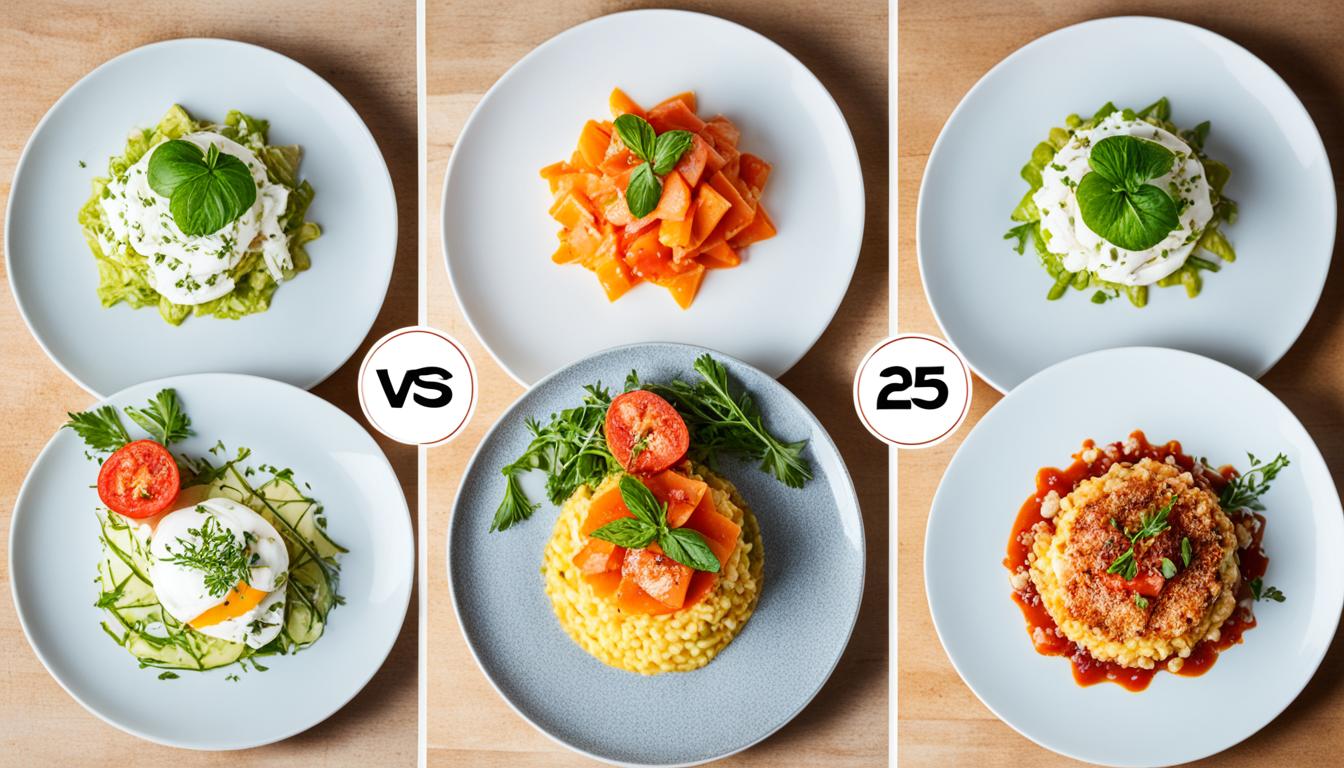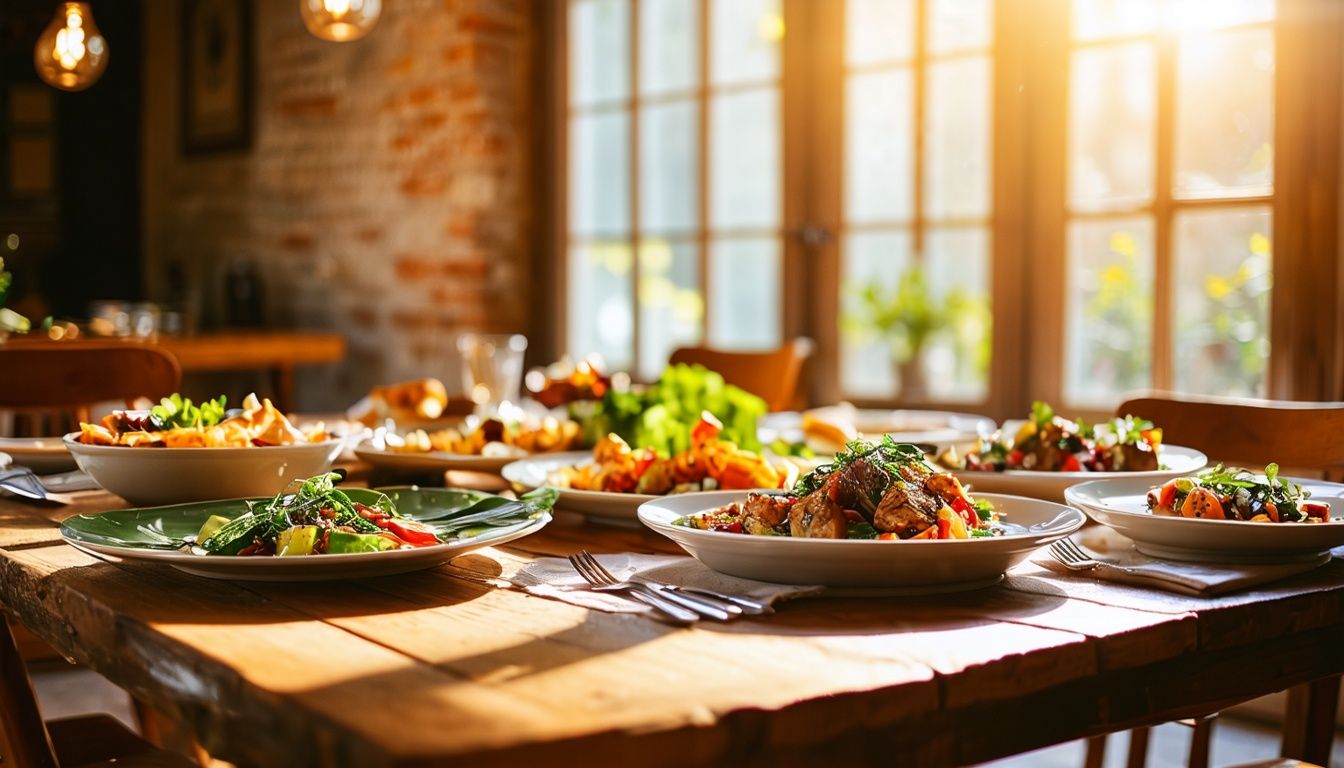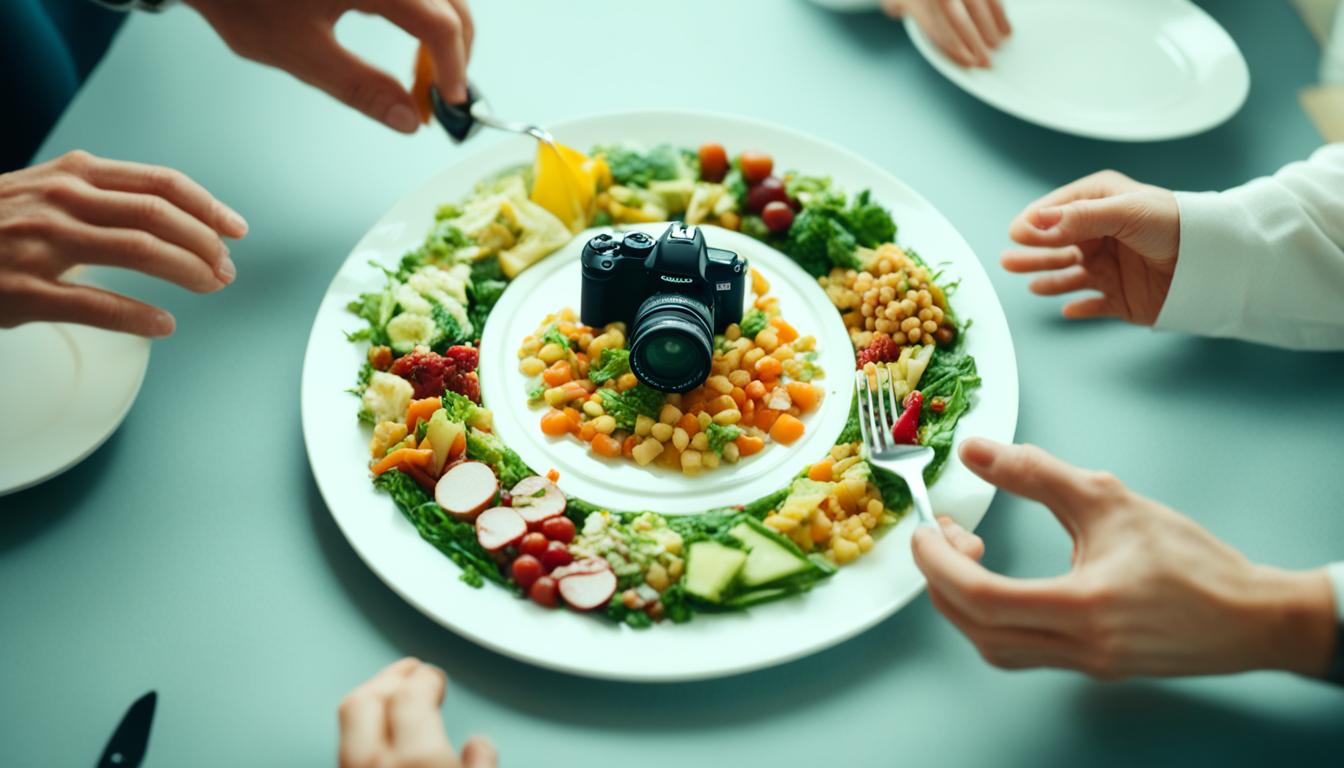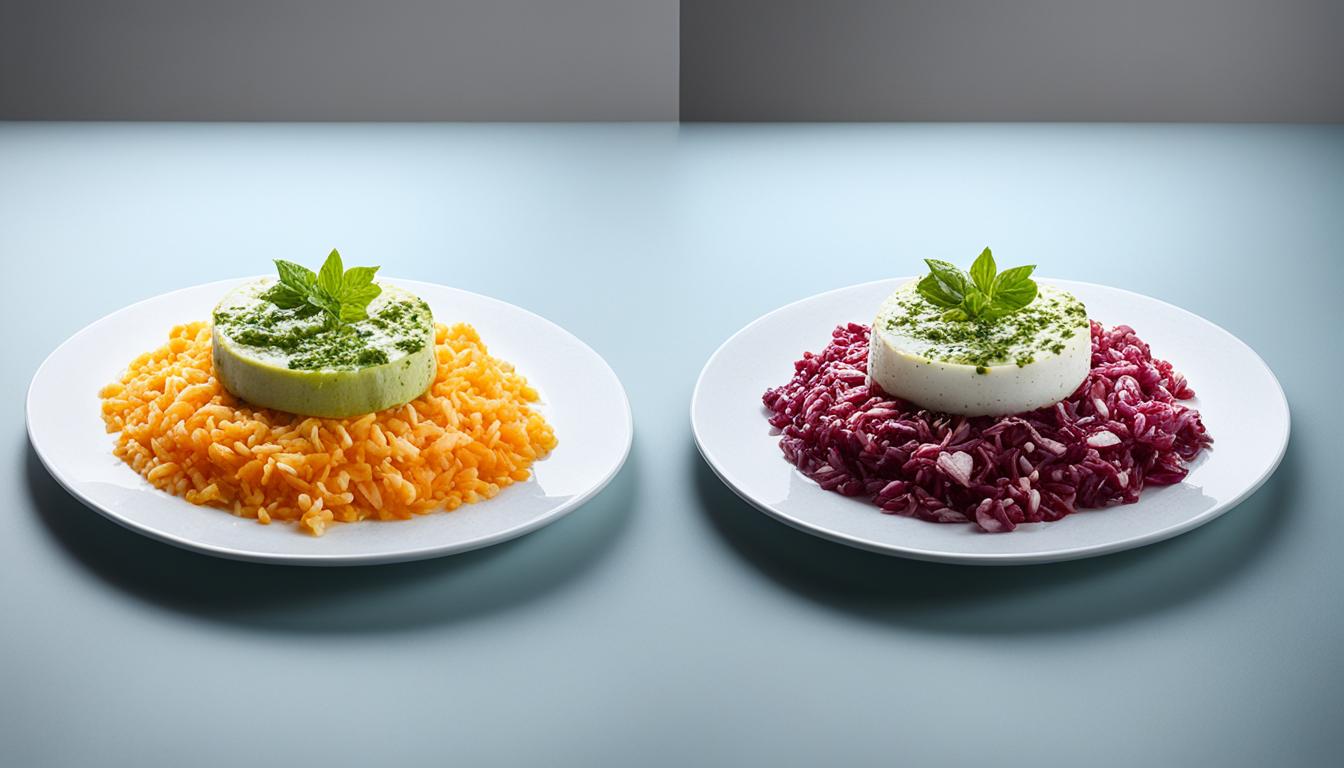When it comes to food photography, the camera angle you choose can make a significant impact on the final image. By selecting the right angle, you can effectively capture the essence of your culinary creations. There are three primary angles to consider: overhead shots, angle shots, and straight-on shots. Each angle has its own unique benefits and considerations. Let’s explore the nuances of overhead vs. angle shots in food photography to help you capture stunning images of your delicious dishes.
Key Takeaways:
- Overhead shots provide a captivating top-down perspective that showcases the entire dish.
- Angle shots add depth and dimension, highlighting specific details and creating a dynamic composition.
- Experimenting with different camera angles can bring a fresh and creative look to your food photography.
- Consider the styling of your food when choosing the right camera angle for capturing its best features.
- By understanding the differences between overhead and angle shots, you can enhance your food photography skills.
The Power of Overhead Shots in Food Photography
When it comes to food photography, capturing the perfect angle can make all the difference in showcasing your culinary creations. One angle that holds immense visual appeal is the overhead shot, also known as a flat lay. These shots provide a captivating top-down perspective that allows you to showcase the entire dish in all its glory.
Overhead shots are highly versatile and suitable for a wide range of food types. Whether you’re photographing a vibrant salad, a decadent dessert, or a mouthwatering burger, this angle allows you to capture the full composition and highlight intricate details. It offers a comprehensive view of the dish, making it a great choice for showcasing elaborate toppings, colorful ingredients, or a beautifully styled table scene.
To achieve stunning overhead shots in food photography, it’s important to use the right equipment and techniques. Consider using a wider angle lens to capture expansive scenes or a longer focal length macro lens for close-up shots that emphasize the finer details. Additionally, using a narrow aperture can help ensure sharp focus throughout the image.
By experimenting with different styling techniques, compositions, and lighting setups, you can create visually striking overhead shots that capture the essence of your culinary creations. So let your creativity soar and explore the power of overhead shots in food photography!
The Power of Angle Shots in Food Photography
When it comes to capturing stunning images of food, the angle you choose can greatly impact the composition and overall aesthetic of your photographs. Angle shots in food photography offer a unique perspective by capturing the dish from a 45° or 75° angle, adding depth, dimension, and visual interest to the image.
By shooting from an angle, you can highlight specific details and create a more dynamic composition that engages the viewer. A 45° angle is ideal for capturing flatter subjects, allowing you to showcase multiple layers and textures. On the other hand, a 75° angle provides a slightly overhead view with a hint of a side view, making it perfect for adding a touch of visual intrigue to your shots.
Angle shots work particularly well for showcasing layered dishes, drinks, and cutting shots. They allow you to capture the intricate details and textures of the food, making it more visually appealing and enticing to the viewer. Experimenting with different angles can bring a fresh and creative look to your food photography, helping you stand out from the crowd and create stunning compositions.
Here are a few tips to make the most of angle shots in food photography:
- Play with different angles: Don’t be afraid to explore various angles and perspectives to find the most flattering and visually interesting composition for your dish.
- Create depth and dimension: Use angle shots to add depth to your images by incorporating foreground and background elements, such as props or ingredients.
- Highlight textures: Angle shots allow you to emphasize the textures of the food, from crispy crusts to gooey centers, creating a mouthwatering visual experience.
- Use leading lines: Incorporate leading lines into your composition to guide the viewer’s eye and create a sense of movement within the image.
Remember, food photography is as much about artistry and creativity as it is about technique. Don’t be afraid to experiment, explore different angles, and push the boundaries of your compositions to create visually stunning images that capture the essence of your culinary creations.

Experimenting with different angles can elevate your food photography and give it a unique perspective. By incorporating angle shots into your repertoire, you can create compositions that engage and captivate your audience. So grab your camera, play with angles, and let your creativity shine through your lens.
The Importance of Camera Angles in Food Photography
When it comes to food photography, the angle from which you capture your dishes plays a crucial role in creating visually stunning images. The right camera angle can enhance the composition, highlight the most appealing features of the food, and tell a compelling visual story. In this section, we’ll delve into the significance of camera angles in food photography and share some valuable tips to help you achieve the perfect shot.
The Art of Food Photography Composition
Food photography composition is all about arranging the elements within the frame to create a visually appealing and balanced image. A well-composed photograph draws the viewer’s attention to the main subject, highlights its details, and evokes a strong emotional response.
To master food photography composition, consider the specific dish you’re photographing and its unique characteristics. Some foods have a natural “most flattering” angle that showcases their best features. For example, if you’re photographing a dish in an opaque bowl with intricate toppings, capturing it from a top-down or 75°-45° angle can provide the best view. On the other hand, tall glasses or layered dishes may benefit from a 45° to straight-on angle to highlight their height and intricate layers.
Highlighting the Most Interesting Details
When planning your camera angles, it’s essential to consider the most interesting details of your food and how they can be showcased from the chosen angle. Is it the vibrant colors of the fresh ingredients? The intricate textures of the dish? Or the steam rising from a piping hot soup?
From the chosen angle, you want to make sure these captivating details take center stage and capture the viewer’s attention. Experimentation is key here—try different angles and perspectives to find the one that best emphasizes the most compelling features of your dish.
Pro Tip: Don’t be afraid to get up close and personal with your food! Macro lenses or close-up shots can help you capture even the tiniest details, adding an extra level of visual interest to your food photography.
Creating Depth and Visual Interest
Camera angles in food photography not only determine what you include in the frame but also how you represent depth and perspective. Different angles can create a sense of depth and add visual interest to your images.
For example, an overhead shot captures the entire scene from above, providing a flat, bird’s-eye view. On the other hand, angle shots—such as capturing the dish from a 45° or 75° angle—add depth by highlighting the height, layers, and textures of the food. These angles can create a more three-dimensional effect and make the viewer feel like they’re a part of the dining experience.
| Camera Angle | Description |
|---|---|
| Overhead Shot | A top-down perspective that captures the entire dish and showcases the composition and table scene. |
| 45° Angle Shot | Adds depth and dimension by highlighting the height, layers, and textures of the food. |
| 75° Angle Shot | Provides a slightly overhead view with a hint of a side view, creating a dynamic composition. |
Experimenting with different camera angles will allow you to discover the ones that work best for your specific dishes and help you create visually stunning images.
Pro Tip: Don’t limit yourself to just one camera angle. Capture your dishes from multiple angles to provide a variety of shots and perspectives. This will give you more options during the editing process and allow you to choose the most compelling images to showcase your culinary creations.
Conclusion
In conclusion, mastering the art of food photography angles is key to elevating your culinary photography skills. Both overhead shots and angle shots have their own unique advantages and can be used to create stunning visual compositions.
Overhead shots, also known as flat lays, offer a captivating top-down perspective that allows you to showcase the entire dish and capture intricate details. This angle is perfect for capturing table scenes and highlighting the beauty of the overall presentation.
On the other hand, angle shots add depth and dimension to your images, bringing a dynamic and engaging look to your food photography. By experimenting with different angles, such as 45° or 75°, you can highlight specific elements of the dish and create visually interesting compositions.
Remember to consider the nature of your dish and how it is styled when choosing a camera angle. With careful planning and creative exploration, you can capture beautiful food photographs that truly showcase the artistry of your culinary creations.
FAQ
What are the benefits of overhead shots in food photography?
Overhead shots, also known as flat lays, provide a captivating top-down perspective that showcases the entire dish in a visually appealing manner. They work well for most types of food, allowing you to capture the full composition and show intricate details.
When should I use angle shots in food photography?
Angle shots add depth and dimension to the image, allowing you to highlight specific details or create a more dynamic composition. They are ideal for showcasing layered dishes, drinks, and cutting shots, and can bring a fresh and creative look to your food photography.
How do I choose the right camera angle for food photography?
When choosing a camera angle, consider the specific dish and how it is styled. Some foods have a natural “most flattering” angle that showcases their best features. Opaque bowls with intricate toppings often look best from a top-down or 75°-45° angle, while tall glasses or layered dishes may benefit from a 45° to straight-on angle.
What can I do to enhance my food photography skills?
Understanding the differences between overhead and angle shots can greatly enhance your food photography skills. Overhead shots provide a comprehensive view of the dish, perfect for showcasing intricate details and table scenes. Angle shots add depth and dimension, allowing you to highlight specific elements and create a dynamic composition. Experimenting with different angles and considering the styling of your food can lead to stunning images.
What are the Best Camera Angles for Food Photography, and How Can DIY Backdrops and Props Enhance the Overall Image?
When it comes to food photography, choosing the right camera angles can make all the difference. For overhead shots, use a tripod to capture a flatlay. DIY backdrops and props like rustic wooden boards or vintage plates can also elevate the overall image, creating a visual feast for the viewer. Explore endless food photography backdrop ideas to enhance your images.




